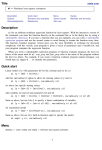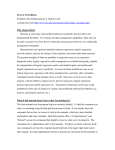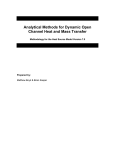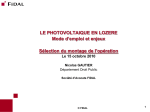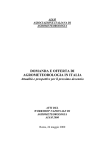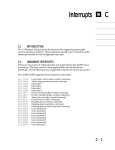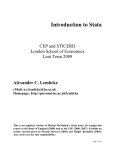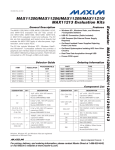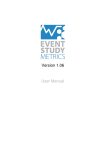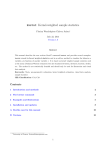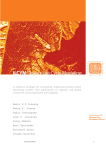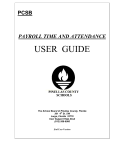Download nl - Stata
Transcript
Title
stata.com
nl — Nonlinear least-squares estimation
Syntax
Remarks and examples
References
Menu
Stored results
Also see
Description
Methods and formulas
Syntax
Interactive version
nl (depvar = <sexp>) if
in
weight
, options
Programmed substitutable expression version
if
in
weight
, options
nl sexp prog : depvar varlist
Function evaluator program version
if
in
weight ,
nl func prog @ depvar varlist
parameters(namelist) | nparameters(#)
options
where
depvar is the dependent variable;
<sexp> is a substitutable expression;
sexp prog is a substitutable expression program; and
func prog is a function evaluator program.
1
Options
Acknowledgments
2
nl — Nonlinear least-squares estimation
Description
options
Model
variables(varlist)
initial(initial values)
∗
parameters(namelist)
∗
nparameters(#)
sexp options
func options
variables in model
initial values for parameters
parameters in model (function evaluator program version only)
number of parameters in model
(function evaluator program version only)
options for substitutable expression program
options for function evaluator program
Model 2
lnlsq(#)
noconstant
hasconstant(name)
use log least-squares where ln(depvar − # ) is assumed to be
normally distributed
the model has no constant term; seldom used
use name as constant term; seldom used
SE/Robust
vce(vcetype)
vcetype may be gnr, robust, cluster clustvar, bootstrap,
jacknife, hac kernel, hc2, or hc3
Reporting
level(#)
leave
title(string)
title2(string)
display options
set confidence level; default is level(95)
create variables containing derivative of E(y)
display string as title above the table of parameter estimates
display string as subtitle
control column formats and line width
Optimization
optimization options
eps(#)
delta(#)
control the optimization process; seldom used
specify # for convergence criterion; default is eps(1e-5)
specify # for computing derivatives; default is delta(4e-7)
coeflegend
display legend instead of statistics
∗
For function evaluator program version, you must specify parameters(namelist) or nparameters(#), or both.
bootstrap, by, jackknife, rolling, statsby, and svy are allowed; see [U] 11.1.10 Prefix commands.
Weights are not allowed with the bootstrap prefix; see [R] bootstrap.
aweights are not allowed with the jackknife prefix; see [R] jackknife.
vce(), leave, and weights are not allowed with the svy prefix; see [SVY] svy.
aweights, fweights, and iweights are allowed; see [U] 11.1.6 weight.
coeflegend does not appear in the dialog box.
See [U] 20 Estimation and postestimation commands for more capabilities of estimation commands.
Menu
Statistics
>
Linear models and related
>
Nonlinear least squares
nl — Nonlinear least-squares estimation
3
Description
nl fits an arbitrary nonlinear regression function by least squares. With the interactive version of
the command, you enter the function directly on the command line or in the dialog box by using a
substitutable expression. If you have a function that you use regularly, you can write a substitutable
expression program and use the second syntax to avoid having to reenter the function every time.
The function evaluator program version gives you the most flexibility in exchange for increased
complexity; with this version, your program is given a vector of parameters and a variable list, and
your program computes the regression function.
When you write a substitutable expression program or function evaluator program, the first two
letters of the name must be nl. sexp prog and func prog refer to the name of the program without
the first two letters. For example, if you wrote a function evaluator program named nlregss, you
would type nl regss @ . . . to estimate the parameters.
Options
Model
variables(varlist) specifies the variables in the model. nl ignores observations for which any of
these variables have missing values. If you do not specify variables(), then nl issues an error
message with return code 480 if the estimation sample contains any missing values.
initial(initial values) specifies the initial values to begin the estimation. You can specify a 1 × k
matrix, where k is the number of parameters in the model, or you can specify a parameter name,
its initial value, another parameter name, its initial value, and so on. For example, to initialize
alpha to 1.23 and delta to 4.57, you would type
nl
. . . , initial(alpha 1.23 delta 4.57) . . .
Initial values declared using this option override any that are declared within substitutable expressions. If you specify a parameter that does not appear in your model, nl exits with error code
480. If you specify a matrix, the values must be in the same order that the parameters are declared
in your model. nl ignores the row and column names of the matrix.
parameters(namelist) specifies the names of the parameters in the model. The names of the
parameters must adhere to the naming conventions of Stata’s variables; see [U] 11.3 Naming
conventions. If you specify both parameters() and nparameters(), the number of names in
the former must match the number specified in the latter; if not, nl issues an error message with
return code 198.
nparameters(#) specifies the number of parameters in the model. If you do not specify names with
the parameters() option, nl names them b1, b2, . . . , b#. If you specify both parameters()
and nparameters(), the number of names in the former must match the number specified in the
latter; if not, nl issues an error message with return code 198.
sexp options refer to any options allowed by your sexp prog.
func options refer to any options allowed by your func prog.
Model 2
lnlsq(#) fits the model by using log least-squares, which we define as least squares with shifted
lognormal errors. In other words, ln(depvar − # ) is assumed to be normally distributed. Sums of
squares and deviance are adjusted to the same scale as depvar.
4
nl — Nonlinear least-squares estimation
noconstant indicates that the function does not include a constant term. This option is generally
not needed, even if there is no constant term in the model, unless the coefficient of variation (over
observations) of the partial derivative of the function with respect to a parameter is less than eps()
and that parameter is not a constant term.
hasconstant(name) indicates that parameter name be treated as the constant term in the model and
that nl should not use its default algorithm to find a constant term. As with noconstant, this
option is seldom used.
SE/Robust
vce(vcetype) specifies the type of standard error reported, which includes types that are derived
from asymptotic theory (gnr), that are robust to some kinds of misspecification (robust), that
allow for intragroup correlation (cluster clustvar), and that use bootstrap or jackknife methods
(bootstrap, jackknife); see [R] vce option.
vce(gnr), the default, uses the conventionally derived variance estimator for nonlinear models fit
using Gauss–Newton regression.
nl also allows the following:
vce(hac kernel # ) specifies that a heteroskedasticity- and autocorrelation-consistent (HAC)
variance estimate be used. HAC refers to the general form for combining weighted matrices to
form the variance estimate. There are three kernels available for nl:
nwest | gallant | anderson
# specifies the number of lags. If # is not specified, N − 2 is assumed.
vce(hac kernel # ) is not allowed if weights are specified.
vce(hc2) and vce(hc3) specify alternative bias corrections for the robust variance calculation.
vce(hc2) and vce(hc3) may not be specified with the svy prefix. By default, vce(robust)
uses σ
bj2 = {n/(n − k)}u2j as an estimate of the variance of the j th observation, where uj is the
calculated residual and n/(n − k) is included to improve the overall estimate’s small-sample
properties.
vce(hc2) instead uses u2j /(1 − hjj ) as the observation’s variance estimate, where hjj is the
j th diagonal element of the hat (projection) matrix. This produces an unbiased estimate of the
covariance matrix if the model is homoskedastic. vce(hc2) tends to produce slightly more
conservative confidence intervals than vce(robust).
vce(hc3) uses u2j /(1 − hjj )2 as suggested by Davidson and MacKinnon (1993 and 2004),
who report that this often produces better results when the model is heteroskedastic. vce(hc3)
produces confidence intervals that tend to be even more conservative.
See, in particular, Davidson and MacKinnon (2004, 239), who advocate the use of vce(hc2)
or vce(hc3) instead of the plain robust estimator for nonlinear least squares.
Reporting
level(#); see [R] estimation options.
leave leaves behind after estimation a set of new variables with the same names as the estimated
parameters containing the derivatives of E(y) with respect to the parameters. If the dataset contains
an existing variable with the same name as a parameter, then using leave causes nl to issue an
error message with return code 110.
leave may not be specified with vce(cluster clustvar) or the svy prefix.
nl — Nonlinear least-squares estimation
5
title(string) specifies an optional title that will be displayed just above the table of parameter
estimates.
title2(string) specifies an optional subtitle that will be displayed between the title specified in
title() and the table of parameter estimates. If title2() is specified but title() is not,
title2() has the same effect as title().
display options: cformat(% fmt), pformat(% fmt), sformat(% fmt), and nolstretch; see [R] estimation options.
Optimization
optimization options: iterate(#), no log, trace. iterate() specifies the maximum number of
iterations, log/nolog specifies whether to show the iteration log, and trace specifies that the
iteration log should include the current parameter vector. These options are seldom used.
eps(#) specifies the convergence criterion for successive parameter estimates and for the residual
sum of squares. The default is eps(1e-5).
delta(#) specifies the relative change in a parameter to be used in computing the numeric derivatives. The derivative for parameter βi is computed as {f (X, β1 , β2 , . . . , βi + d, βi+1 , . . .) −
f (X, β1 , β2 , . . . , βi , βi+1 , . . .)}/d, where d is δ(βi + δ). The default is delta(4e-7).
The following options are available with nl but are not shown in the dialog box:
coeflegend; see [R] estimation options.
Remarks and examples
stata.com
Remarks are presented under the following headings:
Substitutable expressions
Substitutable expression programs
Built-in functions
Lognormal errors
Other uses
Weights
Potential errors
General comments on fitting nonlinear models
Function evaluator programs
nl fits an arbitrary nonlinear function by least squares. The interactive version allows you to enter
the function directly on the command line or dialog box using substitutable expressions. You can
write a substitutable expression program for functions that you fit frequently to save yourself time.
Finally, function evaluator programs give you the most flexibility in defining your nonlinear function,
though they are more complicated to use.
The next section explains the substitutable expressions that are used to define the regression
function, and the section thereafter explains how to write substitutable expression program files so
that you do not need to type in commonly used functions over and over. Later sections highlight
other features of nl.
The final section discusses function evaluator programs. If you find substitutable expressions
adequate to define your nonlinear function, then you can skip that section entirely. Function evaluator
programs are generally needed only for complicated problems, such as multistep estimators. The
program receives a vector of parameters at which it is to compute the function and a variable into
which the results are to be placed.
6
nl — Nonlinear least-squares estimation
Substitutable expressions
You define the nonlinear function to be fit by nl by using a substitutable expression. Substitutable
expressions are just like any other mathematical expressions involving scalars and variables, such as
those you would use with Stata’s generate command, except that the parameters to be estimated are
bound in braces. See [U] 13.2 Operators and [U] 13.3 Functions for more information on expressions.
For example, suppose that you wish to fit the function
yi = β0 (1 − e−β1 xi ) + i
where β0 and β1 are the parameters to be estimated and i is an error term. You would simply type
. nl (y = {b0}*(1 - exp(-1*{b1}*x)))
You must enclose the entire equation in parentheses. Because b0 and b1 are enclosed in braces, nl
knows that they are parameters in the model. nl will initialize b0 and b1 to zero by default. To
request that nl initialize b0 to 1 and b1 to 0.25, you would type
. nl (y = {b0=1}*(1 - exp(-1*{b1=0.25}*x)))
That is, inside the braces denoting a parameter, you put the parameter name followed by an equal sign
and the initial value. If a parameter appears in your function multiple times, you need only specify
an initial value only once (or never, if you wish to set the initial value to zero). If you do specify
more than one initial value for the same parameter, nl will use the last value given. Parameter names
must follow the same conventions as variable names. See [U] 11.3 Naming conventions.
Frequently, even nonlinear functions contain linear combinations of variables. As an example,
suppose that you wish to fit the function
n
o
yi = β0 1 − e−(β1 x1i +β2 x2i +β3 x3i ) + i
nl allows you to declare a linear combination of variables by using the shorthand notation
. nl (y = {b0=1}*(1 - exp(-1*{xb: x1 x2 x3})))
In the syntax {xb: x1 x2 x3}, you are telling nl that you are declaring a linear combination named
xb that is a function of three variables, x1, x2, and x3. nl will create three parameters, named
xb x1, xb x2, and xb x3, and initialize them to zero. Instead of typing the previous command, you
could have typed
. nl (y = {b0=1}*(1 - exp(-1*({xb x1}*x1 + {xb x2}*x2 + {xb x3}*x3))))
and yielded the same result. You can refer to the parameters created by nl in the linear combination
later in the function, though you must declare the linear combination first if you intend to do that.
When creating linear combinations, nl ensures that the parameter names it chooses are unique and
have not yet been used in the function.
In general, there are three rules to follow when defining substitutable expressions:
1.
2.
3.
Parameters of the model are bound in braces: {b0}, {param}, etc.
Initial values for parameters are given by including an equal sign and
the initial value inside the braces: {b0=1}, {param=3.571}, etc.
Linear combinations of variables can be included using the notation
{eqname:varlist}, for example, {xb: mpg price weight}, {score: w x z}, etc.
Parameters of linear combinations are initialized to zero.
nl — Nonlinear least-squares estimation
7
If you specify initial values by using the initial() option, they override whatever initial values
are given within the substitutable expression. Substitutable expressions are so named because, once
values are assigned to the parameters, the resulting expression can be handled by generate and
replace.
Example 1
We wish to fit the CES production function
lnQi = β0 −
1 −ρ
−ρ ln δKi + (1 − δ)Li
+ i
ρ
(1)
where lnQi is the log of output for firm i; Ki and Li are firm i’s capital and labor usage, respectively;
and i is a regression error term. Because ρ appears in the denominator of a fraction, zero is not a
feasible initial value; for a CES production function, ρ = 1 is a reasonable choice. Setting δ = 0.5
implies that labor and capital have equal impacts on output, which is also a reasonable choice for an
initial value. We type
. use http://www.stata-press.com/data/r13/production
. nl (lnoutput = {b0} - 1/{rho=1}*ln({delta=0.5}*capital^(-1*{rho}) +
> (1 - {delta})*labor^(-1*{rho})))
(obs = 100)
Iteration 0: residual SS = 29.38631
Iteration 1: residual SS = 29.36637
Iteration 2: residual SS = 29.36583
Iteration 3: residual SS = 29.36581
Iteration 4: residual SS = 29.36581
Iteration 5: residual SS = 29.36581
Iteration 6: residual SS = 29.36581
Iteration 7: residual SS = 29.36581
SS
df
MS
Source
Number of obs =
100
Model
91.1449924
2 45.5724962
R-squared
=
0.7563
Residual
29.3658055
97 .302740263
Adj R-squared =
0.7513
Root MSE
= .5502184
120.510798
99 1.21728079
Res. dev.
= 161.2538
Total
lnoutput
Coef.
/b0
/rho
/delta
3.792158
1.386993
.4823616
Std. Err.
.099682
.472584
.0519791
t
38.04
2.93
9.28
P>|t|
[95% Conf. Interval]
0.000
0.004
0.000
3.594316
.4490443
.3791975
3.989999
2.324941
.5855258
Parameter b0 taken as constant term in model & ANOVA table
nl will attempt to find a constant term in the model and, if one is found, mention it at the bottom of
the output. nl found b0 to be a constant because the partial derivative ∂ lnQi /∂b0 has a coefficient
of variation less than eps() in the estimation sample.
The elasticity of substitution for the CES production function is σ = 1/(1 + ρ); and, having fit
the model, we can use nlcom to estimate it:
. nlcom (1/(1 + _b[/rho]))
_nl_1: 1/(1 + _b[/rho])
lnoutput
Coef.
_nl_1
.4189372
Std. Err.
z
P>|z|
.0829424
5.05
0.000
[95% Conf. Interval]
.256373
.5815014
8
nl — Nonlinear least-squares estimation
See [R] nlcom and [U] 13.5 Accessing coefficients and standard errors for more information.
nl’s output closely mimics that of regress; see [R] regress for more information. The R2 , sums
of squares, and similar statistics are calculated in the same way that regress calculates them. If
no “constant” term is specified, the usual caveats apply to the interpretation of the R2 statistic; see
the comments and references in Goldstein (1992). Unlike regress, nl does not report a model F
statistic, because a test of the joint significance of all the parameters except the constant term may
not be relevant in a nonlinear model.
Substitutable expression programs
If you fit the same model often or if you want to write an estimator that will operate on whatever
variables you specify, then you will want to write a substitutable expression program. That program
will return a macro containing a substitutable expression that nl can then evaluate, and it may
optionally calculate initial values as well. The name of the program must begin with the letters nl.
To illustrate, suppose that you use the CES production function often in your work. Instead of
typing in the formula each time, you can write a program like this:
program nlces, rclass
version 13
syntax varlist(min=3 max=3) [if]
local logout : word 1 of ‘varlist’
local capital : word 2 of ‘varlist’
local labor : word 3 of ‘varlist’
// Initial value for b0 given delta=0.5 and rho=1
tempvar y
generate double ‘y’ = ‘logout’ + ln(0.5*‘capital’^-1 + 0.5*‘labor’^-1)
summarize ‘y’ ‘if’, meanonly
local b0val = r(mean)
// Terms for substitutable expression
local capterm "{delta=0.5}*‘capital’^(-1*{rho})"
local labterm "(1-{delta})*‘labor’^(-1*{rho})"
local term2
"1/{rho=1}*ln(‘capterm’ + ‘labterm’)"
// Return substitutable expression and title
return local eq "‘logout’ = {b0=‘b0val’} - ‘term2’"
return local title "CES ftn., ln Q=‘logout’, K=‘capital’, L=‘labor’"
end
The program accepts three variables for log output, capital, and labor, and it accepts an if exp
qualifier to restrict the estimation sample. All programs that you write to use with nl must accept
an if exp qualifier because, when nl calls the program, it passes a binary variable that marks the
estimation sample (the variable equals one if the observation is in the sample and zero otherwise).
When calculating initial values, you will want to restrict your computations to the estimation sample,
and you can do so by using if with any commands that accept if exp qualifiers. Even if your
program does not calculate initial values or otherwise use the if qualifier, the syntax statement must
still allow it. See [P] syntax for more information on the syntax command and the use of if.
As in the previous example, reasonable initial values for δ and ρ are 0.5 and 1, respectively.
Conditional on those values, (1) can be rewritten as
β0 = lnQi + ln(0.5Ki−1 + 0.5L−1
i ) − i
(2)
so a good initial value for β0 is the mean of the right-hand side of (2) ignoring i . Lines 7–10 of
the function evaluator program calculate that mean and store it in a local macro. Notice the use of
if in the summarize statement so that the mean is calculated only for the estimation sample.
nl — Nonlinear least-squares estimation
9
The final part of the program returns two macros. The macro title is optional and defines a
short description of the model that will be displayed in the output immediately above the table of
parameter estimates. The macro eq is required and defines the substitutable expression that nl will
use. If the expression is short, you can define it all at once. However, because the expression used
here is somewhat lengthy, defining local macros and then building up the final expression from them
is easier.
To verify that there are no errors in your program, you can call it directly and then use return
list:
. use http://www.stata-press.com/data/r13/production
. nlces lnoutput capital labor
(output omitted )
. return list
macros:
r(title) : "CES ftn., ln Q=lnoutput, K=capital, L=labor"
r(eq) : "lnoutput = {b0=3.711606264663641} - 1/{rho=1}*ln({delt
> a=0.5}*capital^(-1*{rho}) + (1-{delta})*labor^(-1*{rho}))"
The macro r(eq) contains the same substitutable expression that we specified at the command line
in the preceding example, except for the initial value for b0. In short, an nl substitutable expression
program should return in r(eq) the same substitutable expression you would type at the command
line. The only difference is that when writing a substitutable expression program, you do not bind
the entire expression inside parentheses.
Having written the program, you can use it by typing
. nl ces: lnoutput capital labor
(There is a space between nl and ces.) The output is identical to that shown in example 1, save
for the title defined in the function evaluator program that appears immediately above the table of
parameter estimates.
Technical note
You will want to store nlces as an ado-file called nlces.ado. The alternative is to type the code
into Stata interactively or to place the code in a do-file. While those alternatives are adequate for
occasional use, if you save the program as an ado-file, you can use the function anytime you use
Stata without having to redefine the program. When nl attempts to execute nlces, if the program is
not in Stata’s memory, Stata will search the disk(s) for an ado-file of the same name and, if found,
automatically load it. All you have to do is name the file with the .ado suffix and then place it
in a directory where Stata will find it. You should put the file in the directory Stata reserves for
user-written ado-files, which, depending on your operating system, is c:\ado\personal (Windows),
~ /ado/personal (Unix), or ~:ado:personal (Mac). See [U] 17 Ado-files.
Sometimes you may want to pass additional options to the substitutable expression program. You
can modify the syntax statement of your program to accept whatever options you wish. Then when
you call nl with the syntax
. nl func prog: varlist, options
any options that are not recognized by nl (see the table of options at the beginning of this entry) are
passed on to your function evaluator program. The only other restriction is that your program cannot
accept an option named at because nl uses that option with function evaluator programs.
10
nl — Nonlinear least-squares estimation
Built-in functions
Some functions are used so often that nl has them built in so that you do not need to write
them yourself. nl automatically chooses initial values for the parameters, though you can use the
initial(. . .) option to override them.
Three alternatives are provided for exponential regression with one asymptote:
exp3
yi = β0 + β1 β2xi + i
exp2
yi = β1 β2xi + i
exp2a
yi = β1 1 − β2xi + i
For instance, typing nl exp3: ras dvl fits the three-parameter exponential model (parameters β0 ,
β1 , and β2 ) using yi = ras and xi = dvl.
Two alternatives are provided for the logistic function (symmetric sigmoid shape; not to be confused
with logistic regression):
.h
i
log4
yi = β0 + β1 1 + exp −β2 (xi − β3 ) + i
.h
i
log3
yi = β1 1 + exp −β2 (xi − β3 ) + i
Finally, two alternatives are provided for the Gompertz function (asymmetric sigmoid shape):
h
i
gom4
yi = β0 + β1 exp − exp −β2 (xi − β3 ) + i
h
i
gom3
yi = β1 exp − exp −β2 (xi − β3 ) + i
Lognormal errors
A nonlinear model with errors that are independent and identically distributed normal may be
written as
yi = f (xi , β) + ui ,
ui ∼ N (0, σ 2 )
(3)
for i = 1, . . . , n. If the yi are thought to have a k -shifted lognormal instead of a normal distribution—
that is, ln(yi − k) ∼ N (ζi , τ 2 ), and the systematic part f (xi , β) of the original model is still thought
appropriate for yi —the model becomes
ln(yi − k) = ζi + vi = ln f (xi , β) − k + vi , vi ∼ N (0, τ 2 )
(4)
This model is fit if lnlsq(k ) is specified.
2
If model (4) is correct, the variance of (yi − k) is proportional to f (xi , β) − k . Probably the
most common case is k = 0, sometimes called “proportional errors” because the standard error of yi
is proportional to its expectation, f (xi , β). Assuming that the value of k is known, (4) is just another
nonlinear model in β, and it may be fit as usual. However, we may wish to compare the fit of (3) with
that of (4) using the residual sum of squares (RSS) or the deviance D, D = −2 × log-likelihood, from
each model. To do so, we must allow for the change in scale introduced by the log transformation.
Assuming,Qthen, the yi to be normally distributed, Atkinson (1985, 85–87, 184), by considering
the Jacobian |∂ ln(yi − k)/∂yi |, showed that multiplying both sides of (4) by the geometric mean
of yi − k , ẏ , gives residuals on the same scale as those of yi . The geometric mean is given by
P
−1
ln(yi −k)
ẏ = en
which is a constant for a given dataset. The residual deviance for (3) and for (4) may be expressed
as
n
o
b ) = 1 + ln(2πb
D(β
σ2 ) n
(5)
nl — Nonlinear least-squares estimation
11
b is the maximum likelihood estimate (MLE) of β for each model and nb
where β
σ 2 is the RSS from
2
(3), or that from (4) multiplied by ẏ .
Because (3) and (4) are models with different error structures but the same functional form, the
arithmetic difference in their RSS or deviances is not easily tested for statistical significance. However,
if the deviance difference is large (>4, say), we would naturally prefer the model with the smaller
deviance. Of course, the residuals for each model should be examined for departures from assumptions
(nonconstant variance, nonnormality, serial correlations, etc.) in the usual way.
Alternatively, consider modeling
E(yi ) = 1/(C + AeBxi )
(6)
E(1/yi ) = E(yi0 ) = C + AeBxi
(7)
where C , A, and B are parameters to be estimated. Using the data (y, x) = (0.04, 5), (0.06, 12),
(0.08, 25), (0.1, 35), (0.15, 42), (0.2, 48), (0.25, 60), (0.3, 75), and (0.5, 120) (Danuso 1991), fitting
the models yields
Model
(6)
(6) with lnlsq(0)
(7)
(7) with lnlsq(0)
C
A
1.781 25.74
1.799 25.45
1.781 25.74
1.799 27.45
B
RSS Deviance
−0.03926 −0.001640
−51.95
−0.04051 −0.001431
−53.18
−0.03926
8.197
24.70
−0.04051
3.651
17.42
There is little to choose between the two versions of the logistic model (6), whereas for the exponential
model (7), the fit using lnlsq(0) is much better (a deviance difference of 7.28). The reciprocal
transformation has introduced heteroskedasticity into yi0 , which is countered by the proportional
errors property of the lognormal distribution implicit in lnlsq(0). The deviances are not comparable
between the logistic and exponential models because the change of scale has not been allowed for,
although in principle it could be.
Other uses
Even if you are fitting linear regression models, you may find that nl can save you some typing.
Because you specify the parameters of your model explicitly, you can impose constraints on them
directly.
Example 2
In example 2 of [R] cnsreg, we showed how to fit the model
mpg = β0 + β1 price + β2 weight + β3 displ + β4 gear ratio + β5 foreign +
β6 length + u
subject to the constraints
β1 = β2 = β3 = β6
β4 = −β5 = β0 /20
12
nl — Nonlinear least-squares estimation
An alternative way is to use nl:
. use http://www.stata-press.com/data/r13/auto, clear
(1978 Automobile Data)
. nl (mpg = {b0} + {b1}*price + {b1}*weight + {b1}*displ +
> {b0}/20*gear_ratio - {b0}/20*foreign + {b1}*length)
(obs = 74)
Iteration 0: residual SS = 1578.522
Iteration 1: residual SS = 1578.522
Source
SS
df
MS
Number of obs
34429.4777
2 17214.7389
R-squared
Model
Residual
1578.52226
72 21.9239203
Adj R-squared
Root MSE
Total
36008
74 486.594595
Res. dev.
mpg
Coef.
/b0
/b1
26.52229
-.000923
Std. Err.
1.375178
.0001534
t
P>|t|
19.29
-6.02
0.000
0.000
=
=
=
=
=
74
0.9562
0.9549
4.682299
436.4562
[95% Conf. Interval]
23.78092
-.0012288
29.26365
-.0006172
The point estimates and standard errors for β0 and β1 are identical to those reported in example 2
of [R] cnsreg. To get the estimate for β4 , we can use nlcom:
. nlcom _b[/b0]/20
_nl_1: _b[/b0]/20
mpg
Coef.
_nl_1
1.326114
Std. Err.
.0687589
z
19.29
P>|z|
[95% Conf. Interval]
0.000
1.191349
1.460879
The advantage to using nl is that we do not need to use the constraint command six times.
nl is also a useful tool when doing exploratory data analysis. For example, you may want to run
a regression of y on a function of x, though you have not decided whether to use sqrt(x) or ln(x).
You can use nl to run both regressions without having first to generate two new variables:
. nl (y = {b0} + {b1}*ln(x))
. nl (y = {b0} + {b1}*sqrt(x))
Poi (2008) shows the advantages of using nl when marginal effects of transformed variables are
desired as well.
Weights
Weights are specified in the usual way — analytic and frequency weights as well as iweights
are supported; see [U] 20.23 Weighted estimation. Use of analytic weights implies that the yi have
different variances. Therefore, model (3) may be rewritten as
yi = f (xi , β) + ui ,
ui ∼ N (0, σ 2 /wi )
(3a)
where wi are (positive) weights, assumed to be known and normalized such that their sum equals the
number of observations. The residual deviance for (3a) is
X
b ) = 1 + ln(2πb
D(β
σ2 ) n −
ln(wi )
(5a)
nl — Nonlinear least-squares estimation
13
[compare with (5)], where
nb
σ 2 = RSS =
X
b) 2
wi yi − f (xi , β
Defining and fitting a model equivalent to (4) when weights have been specified as in (3a) is not
straightforward and has not been attempted. Thus deviances using and not using the lnlsq() option
may not be strictly comparable when analytic weights (other than 0 and 1) are used.
You do not need to modify your substitutable expression in any way to use weights. If, however,
you write a substitutable expression program, then you should account for weights when obtaining
initial values. When nl calls your program, it passes whatever weight expression (if any) was specified
by the user. Here is an outline of a substitutable expression program that accepts weights:
program nl name, rclass
version 13
syntax varlist [aw fw iw] if
...
// Obtain initial values allowing weights
// Use the syntax [‘weight’‘exp’]. For example,
summarize varname [‘weight’‘exp’] ‘if’
regress depvar varlist [‘weight’‘exp’] ‘if’
...
// Return substitutable expression
return local eq "substitutable expression"
return local title "description of estimator"
end
For details on how the syntax command processes weight expressions, see [P] syntax.
Potential errors
nl is reasonably robust to the inability of your nonlinear function to be evaluated at some parameter
values. nl does assume that your function can be evaluated at the initial values of the parameters. If
your function cannot be evaluated at the initial values, an error message is issued with return code
480. Recall that if you do not specify an initial value for a parameter, then nl initializes it to zero.
Many nonlinear functions cannot be evaluated when some parameters are zero, so in those cases
specifying alternative initial values is crucial.
Thereafter, as nl changes the parameter values, it monitors your function for unexpected missing
values. If these are detected, nl backs up. That is, nl finds a point between the previous, known-tobe-good parameter vector and the new, known-to-be-bad vector at which the function can be evaluated
and continues its iterations from that point.
nl requires that once a parameter vector is found where the predictions can be calculated, small
changes to the parameter vector be made to calculate numeric derivatives. If a boundary is encountered
at this point, an error message is issued with return code 481.
When specifying lnlsq(), an attempt to take logarithms of yi − k when yi ≤ k results in an
error message with return code 482.
If iterate() iterations are performed and estimates still have not converged, results are presented
with a warning, and the return code is set to 430.
If you use the programmed substitutable expression version of nl with a function evaluator program,
or vice versa, Stata issues an error message. Verify that you are using the syntax appropriate for the
program you have.
14
nl — Nonlinear least-squares estimation
General comments on fitting nonlinear models
Achieving convergence is often problematic. For example, a unique minimum of the sum-ofsquares function may not exist. Much literature exists on different algorithms that have been used,
on strategies for obtaining good initial parameter values, and on tricks for parameterizing the model
to make its behavior as linear-like as possible. Selected references are Kennedy and Gentle (1980,
chap. 10) for computational matters and Ross (1990) and Ratkowsky (1983) for all three aspects.
Ratkowsky’s book is particularly clear and approachable, with useful discussion on the meaning and
practical implications of intrinsic and parameter-effects nonlinearity. An excellent text on nonlinear
estimation is Gallant (1987). Also see Davidson and MacKinnon (1993 and 2004).
To enhance the success of nl, pay attention to the form of the model fit, along the lines of
Ratkowsky and Ross. For example, Ratkowsky (1983, 49–59) analyzes three possible three-parameter
yield-density models for plant growth:
(α + βxi )−1/θ
E(yi ) = (α + βxi + γx2i )−1
(α + βxφi )−1
All three models give similar fits. However, he shows that the second formulation is dramatically
more linear-like than the other two and therefore has better convergence properties. In addition, the
parameter estimates are virtually unbiased and normally distributed, and the asymptotic approximation
to the standard errors, correlations, and confidence intervals is much more accurate than for the other
models. Even within a given model, the way the parameters are expressed (for example, φxi or eθxi )
affects the degree of linearity and convergence behavior.
Function evaluator programs
Occasionally, a nonlinear function may be so complex that writing a substitutable expression for it
is impractical. For example, there could be many parameters in the model. Alternatively, if you are
implementing a two-step estimator, writing a substitutable expression may be altogether impossible.
Function evaluator programs can be used in these situations.
nl will pass to your function evaluator program a list of variables, a weight expression, a variable
marking the estimation sample, and a vector of parameters. Your program is to replace the dependent
variable, which is the first variable in the variables list, with the values of the nonlinear function
evaluated at those parameters. As with substitutable expression programs, the first two letters of the
name must be nl.
To focus on the mechanics of the function evaluator program, again let’s compare the CES production
function to the previous examples. The function evaluator program is
nl — Nonlinear least-squares estimation
15
program nlces2
version 13
syntax varlist(min=3 max=3) if, at(name)
local logout : word 1 of ‘varlist’
local capital : word 2 of ‘varlist’
local labor : word 3 of ‘varlist’
// Retrieve parameters out of at matrix
tempname b0 rho delta
scalar ‘b0’ = ‘at’[1, 1]
scalar ‘rho’ = ‘at’[1, 2]
scalar ‘delta’ = ‘at’[1, 3]
tempvar kterm lterm
generate double ‘kterm’ = ‘delta’*‘capital’^(-1*‘rho’) ‘if’
generate double ‘lterm’ = (1-‘delta’)*‘labor’^(-1*‘rho’) ‘if’
// Fill in dependent variable
replace ‘logout’ = ‘b0’ - 1/‘rho’*ln(‘kterm’ + ‘lterm’) ‘if’
end
Unlike the previous nlces program, this one is not declared to be r-class. The syntax statement
again accepts three variables: one for log output, one for capital, and one for labor. An if exp is
again required because nl will pass a binary variable marking the estimation sample. All function
evaluator programs must accept an option named at() that takes a name as an argument—that is
how nl passes the parameter vector to your program.
The next part of the program retrieves the output, labor, and capital variables from the variables
list. It then breaks up the temporary matrix at and retrieves the parameters b0, rho, and delta. Pay
careful attention to the order in which the parameters refer to the columns of the at matrix because
that will affect the syntax you use with nl. The temporary names you use inside this program are
immaterial, however.
The rest of the program computes the nonlinear function, using some temporary variables to hold
intermediate results. The final line of the program then replaces the dependent variable with the values
of the function. Notice the use of ‘if’ to restrict attention to the estimation sample. nl makes a
copy of your dependent variable so that when the command is finished your data are left unchanged.
To use the program and fit your model, you type
. use http://www.stata-press.com/data/r13/production, clear
. nl ces2 @ lnoutput capital labor, parameters(b0 rho delta)
> initial(b0 0 rho 1 delta 0.5)
The output is again identical to that shown in example 1. The order in which the parameters were
specified in the parameters() option is the same in which they are retrieved from the at matrix in
the program. To initialize them, you simply list the parameter name, a space, the initial value, and
so on.
If you use the nparameters() option instead of the parameters() option, the parameters are
named b1, b2, . . . , bk , where k is the number of parameters. Thus you could have typed
. nl ces2 @ lnoutput capital labor, nparameters(3) initial(b1 0 b2 1 b3 0.5)
With that syntax, the parameters called b0, rho, and delta in the program will be labeled b1, b2,
and b3, respectively. In programming situations or if there are many parameters, instead of listing
the parameter names and initial values in the initial() option, you may find it more convenient
to pass a column vector. In those cases, you could type
. matrix myvals = (0, 1, 0.5)
. nl ces2 @ lnoutput capital labor, nparameters(3) initial(myvals)
16
nl — Nonlinear least-squares estimation
In summary, a function evaluator program receives a list of variables, the first of which is the
dependent variable that you are to replace with the values of your nonlinear function. Additionally,
it must accept an if exp, as well as an option named at that will contain the vector of parameters
at which nl wants the function evaluated. You are then free to do whatever is necessary to evaluate
your function and replace the dependent variable.
If you wish to use weights, your function evaluator program’s syntax statement must accept
them. If your program consists only of, for example, generate statements, you need not do anything
with the weights passed to your program. However, if in calculating the nonlinear function you
use commands such as summarize or regress, then you will want to use the weights with those
commands.
As with substitutable expression programs, nl will pass to it any options specified that nl does
not accept, providing you with a way to pass more information to your function.
Technical note
Before version 9 of Stata, the nl command used a different syntax, which required you to write
an nlfcn program, and it did not have a syntax for interactive use other than the seven functions that
were built-in. The old syntax of nl still works, and you can still use those nlfcn programs. If nl
does not see a colon, an at sign, or a set of parentheses surrounding the equation in your command,
it assumes that the old syntax is being used.
The current version of nl uses scalars and matrices to store intermediate calculations instead of
local and global macros as the old version did, so the current version produces more accurate results.
In practice, however, any discrepancies are likely to be small.
nl — Nonlinear least-squares estimation
Stored results
nl stores the following in e():
Scalars
e(N)
e(k)
e(k eq model)
e(df m)
e(df r)
e(df t)
e(mss)
e(rss)
e(tss)
e(mms)
e(msr)
e(ll)
e(r2)
e(r2 a)
e(rmse)
e(dev)
e(N clust)
e(lnlsq)
e(log t)
e(gm 2)
e(cj)
e(delta)
e(rank)
e(ic)
e(converge)
Macros
e(cmd)
e(cmdline)
e(depvar)
e(wtype)
e(wexp)
e(title)
e(title 2)
e(clustvar)
e(hac kernel)
e(hac lag)
e(vce)
e(vcetype)
e(type)
e(sexp)
e(params)
e(funcprog)
e(rhs)
e(properties)
e(predict)
e(marginsnotok)
Matrices
e(b)
e(init)
e(V)
Functions
e(sample)
number of observations
number of parameters
number of equations in overall model test; always 0
model degrees of freedom
residual degrees of freedom
total degrees of freedom
model sum of squares
residual sum of squares
total sum of squares
model mean square
residual mean square
log likelihood assuming i.i.d. normal errors
R-squared
adjusted R-squared
root mean squared error
residual deviance
number of clusters
value of lnlsq if specified
1 if lnlsq specified, 0 otherwise
square of geometric mean of (y−k) if lnlsq; 1 otherwise
position of constant in e(b) or 0 if no constant
relative change used to compute derivatives
rank of e(V)
number of iterations
1 if converged, 0 otherwise
nl
command as typed
name of dependent variable
weight type
weight expression
title in estimation output
secondary title in estimation output
name of cluster variable
HAC kernel
HAC lag
vcetype specified in vce()
title used to label Std. Err.
1 = interactively entered expression
2 = substitutable expression program
3 = function evaluator program
substitutable expression
names of parameters
function evaluator program
contents of variables()
b V
program used to implement predict
predictions disallowed by margins
coefficient vector
initial values vector
variance–covariance matrix of the estimators
marks estimation sample
17
18
nl — Nonlinear least-squares estimation
Methods and formulas
The derivation here is based on Davidson and MacKinnon (2004, chap. 6). Let β denote the k × 1
vector of parameters, and write the regression function using matrix notation as y = f (x, β) + u so
that the objective function can be written as
SSR(β)
0
= {y − f (x, β)} D {y − f (x, β)}
The D matrix contains the weights and is defined in [R] regress; if no weights are specified, then D
is the N × N identity matrix. Taking a second-order Taylor series expansion centered at β0 yields
SSR(β)
1
≈ SSR(β0 ) + g0 (β0 )(β − β0 ) + (β − β0 )0 H(β0 )(β − β0 )
2
(8)
where g(β0 ) denotes the k × 1 gradient of SSR(β) evaluated at β0 and H(β0 ) denotes the k × k
Hessian of SSR(β) evaluated at β0 . Letting X denote the N × k matrix of derivatives of f (x, β)
with respect to β, the gradient g(β) is
g(β) = −2X0 Du
(9)
X and u are obviously functions of β, though for notational simplicity that dependence is not shown
explicitly. The (m, n) element of the Hessian can be written as
Hmn (β) = −2
i=N
X
i=1
dii
∂ 2 fi
ui − Xim Xin
∂βm ∂βn
(10)
where dii is the ith diagonal element of D. As discussed in Davidson and MacKinnon (2004, chap. 6),
the first term inside the brackets of (10) has expectation zero, so the Hessian can be approximated as
H(β) = 2X0 DX
(11)
Differentiating the Taylor series expansion of SSR(β) shown in (8) yields the first-order condition
for a minimum
g(β0 ) + H(β0 )(β − β0 ) = 0
which suggests the iterative procedure
βj+1 = βj − αH−1 (βj )g(βj )
(12)
where α is a “step size” parameter chosen at each iteration to improve convergence. Using (9) and
(11), we can write (12) as
βj+1 = βj + α(X0 DX)−1 X0 Du
(13)
where X and u are evaluated at βj . Apart from the scalar α, the second term on the right-hand
side of (13) can be computed via a (weighted) regression of the columns of X on the errors. nl
computes the derivatives numerically and then calls regress. At each iteration, α is set to one, and
a candidate value β∗j+1 is computed by (13). If SSR(β∗j+1 ) < SSR(βj ), then βj+1 = β∗j+1 and the
iteration is complete. Otherwise, α is halved, a new β∗j+1 is calculated, and the process is repeated.
Convergence is declared when α|βj+1,m | ≤ (|βjm | + τ ) for all m = 1, . . . , k . nl uses τ = 10−3
and, by default, = 10−5 , though you can specify an alternative value of with the eps() option.
nl — Nonlinear least-squares estimation
19
As derived, for example, in Davidson and MacKinnon (2004, chap. 6), an expedient way to
b and then
obtain the covariance matrix is to compute u and the columns of X at the final estimate β
regress that u on X. The covariance matrix of the estimated parameters of that regression serves
b ). If that regression employs a robust covariance matrix estimator, then the
as an estimate of Var(β
covariance matrix for the parameters of the nonlinear regression will also be robust.
All other statistics are calculated analogously to those in linear regression, except that the nonlinear
function f (xi , β) plays the role of the linear function x0i β. See [R] regress.
This command supports estimation with survey data. For details on VCEs with survey data, see
[SVY] variance estimation.
Acknowledgments
The original version of nl was written by Patrick Royston (1992) of the MRC Clinical Trials
Unit, London, and coauthor of the Stata Press book Flexible Parametric Survival Analysis Using
Stata: Beyond the Cox Model. Francesco Danuso’s menu-driven nonlinear regression program (1991)
provided the inspiration.
References
Atkinson, A. C. 1985. Plots, Transformations, and Regression: An Introduction to Graphical Methods of Diagnostic
Regression Analysis. Oxford: Oxford University Press.
Canette, I. 2011. A tip to debug your nl/nlsur function evaluator program. The Stata Blog: Not Elsewhere Classified.
http://blog.stata.com/2011/12/05/a-tip-to-debug-your-nlnlsur-function-evaluator-program/.
Danuso, F. 1991. sg1: Nonlinear regression command. Stata Technical Bulletin 1: 17–19. Reprinted in Stata Technical
Bulletin Reprints, vol. 1, pp. 96–98. College Station, TX: Stata Press.
Davidson, R., and J. G. MacKinnon. 1993. Estimation and Inference in Econometrics. New York: Oxford University
Press.
. 2004. Econometric Theory and Methods. New York: Oxford University Press.
Gallant, A. R. 1987. Nonlinear Statistical Models. New York: Wiley.
Goldstein, R. 1992. srd7: Adjusted summary statistics for logarithmic regressions. Stata Technical Bulletin 5: 17–21.
Reprinted in Stata Technical Bulletin Reprints, vol. 1, pp. 178–183. College Station, TX: Stata Press.
Kennedy, W. J., Jr., and J. E. Gentle. 1980. Statistical Computing. New York: Dekker.
Poi, B. P. 2008. Stata tip 58: nl is not just for nonlinear models. Stata Journal 8: 139–141.
Ratkowsky, D. A. 1983. Nonlinear Regression Modeling: A Unified Practical Approach. New York: Dekker.
Ross, G. J. S. 1987. MLP User Manual, Release 3.08. Oxford: Numerical Algorithms Group.
. 1990. Nonlinear Estimation. New York: Springer.
Royston, P. 1992. sg7: Centile estimation command. Stata Technical Bulletin 8: 12–15. Reprinted in Stata Technical
Bulletin Reprints, vol. 2, pp. 122–125. College Station, TX: Stata Press.
. 1993. sg1.4: Standard nonlinear curve fits. Stata Technical Bulletin 11: 17. Reprinted in Stata Technical Bulletin
Reprints, vol. 2, p. 121. College Station, TX: Stata Press.
20
nl — Nonlinear least-squares estimation
Also see
[R] nl postestimation — Postestimation tools for nl
[R] gmm — Generalized method of moments estimation
[R] ml — Maximum likelihood estimation
[R] mlexp — Maximum likelihood estimation of user-specified expressions
[R] nlcom — Nonlinear combinations of estimators
[R] nlsur — Estimation of nonlinear systems of equations
[R] regress — Linear regression
[SVY] svy estimation — Estimation commands for survey data
[U] 20 Estimation and postestimation commands




















